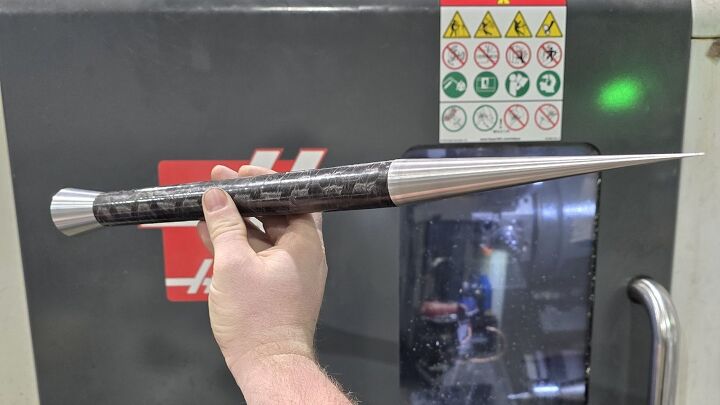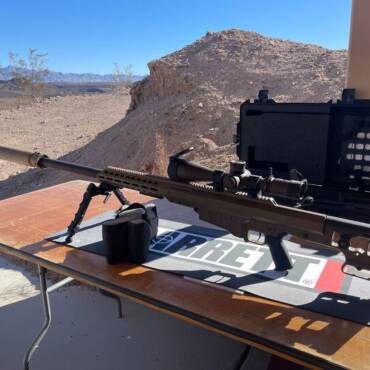The Hyper Velocity Rocket – Wild Arms Research and Development

Over the years I’ve had the personal pleasure of getting to know Jonathan of Wild Arms Research and Development. His solo mission to push the boundaries of DIY rocket and launcher projects has grown from his first attempts at a DIY Panzerfaust, all the way through the epic events surrounding his M202 FLASH project, and now with the new Hyper Velocity Rocket project.
The subject of his latest book, Johnny has spent the last couple of years doing a deep dive into the world of hypervelocity kinetic energy rockets, a technology that relies on sheer speed rather than explosive payloads to penetrate armor. This project began with a thorough exploration of decades of history, tracing the evolution of these rockets back to the 1960s with the development of the SPIKE rocket for the Avenger and Cobra platforms. Jonathan has sifted through digital archives, rifled through countless patents, filed FOIA requests, and even interviewed former engineers while working with museum collections. With all this effort, his next book is going to be his best yet.
More from Wild Arms Research and Development @ TFB:

The Hyper Velocity Rocket – Wild Arms Research and Development
The inspiration for this project – the SPIKE rocket – is a 2-inch diameter rocket engineered to launch a 1-pound tungsten rod at speeds around 5000 FPS. Initially developed during the Cold War as an anti-armor weapon (with variants even aimed at countering advanced helicopters), every detail from the motor construction and nozzle materials to the precise dimensions had to be accounted for and replicated by Johnny to get a modern variant working with the materials and tools he has access to.

“The original design I wanted to recreate and test for the book was a rocket called SPIKE (Single Penetrator Kinetic energy) which was a 2” diameter rocket that carried 1 pound tungsten rod that traveled 5000 FPS. Originally designed as an anti armor weapon for vehicles and helicopters, a variant that dispensed dozens of small tungsten penetrators was developed to counter Russian Helicopters in the Cold War. 2 years of research went into figuring out every aspect about this rocket from motor construction, nozzle materials, to dimensions.”

According to Johnny, a major hurdle came in the form of the propellant. Although it was based on the same type used in reproduction rockets like the M202 and Fliegerfaust, this project required an extremely fine oxidizer particle size—a detail that classified it as an explosive material by the ATF. Despite unearthing a patent that outlined the formula, key details were missing and when it comes to rocketry, you don’t really want to be taking any wild guesses as to its exact composition. Lengthy bureaucratic challenges and the complex logistics of obtaining a federal explosives license meant that Jonathan had to consider alternative designs as do many other DIY rocket builders.

In a fortunate twist, a supporter of the project discovered an obscure early patent that detailed a simpler 1-inch diameter rocket. Initially projected to reach 9000 FPS (though material limitations brought it down to about 7000 FPS), this design skipped the complications of an explosive payload by using a solid projectile. Months of more dedicated research allowed Jonathan to gather enough details to start recreating and testing this slightly altered design from the 2” SPIKE. Replicating the actual launcher seen in some of the diagrams might be a bit of a pipe dream though.
“A supporter of the page stumbled upon a patent buried in google patents that were not previously found which detailed a very early kinetic energy hypervelocity rockets that were simple and predated the very advanced propellants that used the regulated oxidizer particle size. The 1” diameter rocket was projected to travel 9,000 FPS, although material limitations limited the rocket to 7,000 FPS. The rocket lacked any explosive payload and was just a solid projectile. Several months of research went into this very obscure design but enough was recovered to be able to start recreating it and testing it.”


With support from his community—raising around $4000—Jonathan was able to have custom components manufactured for the project. He collaborated with Black Locust Design LLC who stepped in to manufacture the rocket hardware that included nosecones and nozzle assemblies. A lot of testing is required before these ever get fired from static motor tests, testing inhibitor materials, and simulated heat tests on the nose cone, but we are a major step forward. Meanwhile, Reaction Composites helped out by producing filament-wound carbon fiber tubes with high-temperature resin matrices for a robust yet lightweight motor case. Johnny in the meantime has been busy developing a new launcher that spins the rocket as it launches, providing a stabilizing spin that increases the likelihood of a successful, predictable, and accurate flight path.

Johnny is likely to start testing these rockets in the coming months, provided he can get his initial set of rigorous and extensive tests done to confirm fuel and rocket stability. In addition to a lot of the research, design work, and manufacturing work that Johnny does to make these rocket projects happen, he’s also hard at work most of the time setting up test fires. Not just to see if the rockets work, but to compare them to the historical representations that inspired these projects in the first place.

The legal challenges didn’t slow him down either. Jonathan navigated the complex regulatory landscape by consulting independent attorneys, a former ATF agent turned industry expert, and even securing a written opinion from a regional BATF head—all to ensure that his work complies fully with the law and that his latest project won’t wind him up in jail.

New Book Coming Soon!
As he continues testing and refining his design, Jonathan is also documenting every step of his journey. His forthcoming book will not only share the technical build diary of the Hyper Velocity Rocket but also chronicle the fascinating history of these high-speed projectiles. Those of you who have purchased his books in the past will know that these books are full of great pictures (many of which you’ll see in this article), lots of technical details, as well as a very underrated section on the history and development of the inspiration for the project.

Stay tuned for more updates—and be sure to check out Johnny’s social media pages and YouTube channel for updates on this and other rocket projects from Wild Arms Research and Development.



